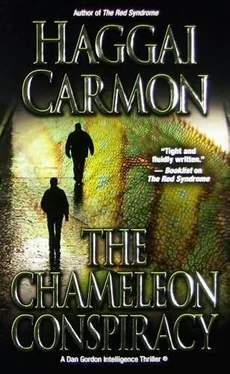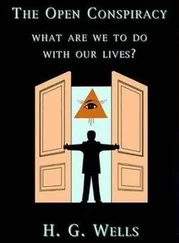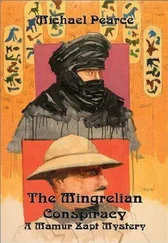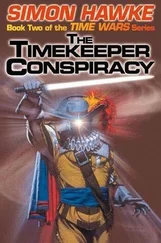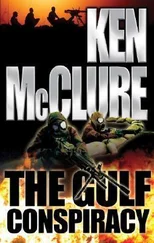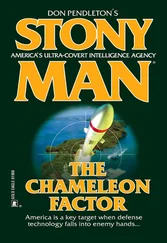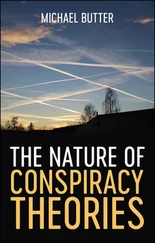Haggai Harmon - The Chameleon Conspiracy
Здесь есть возможность читать онлайн «Haggai Harmon - The Chameleon Conspiracy» весь текст электронной книги совершенно бесплатно (целиком полную версию без сокращений). В некоторых случаях можно слушать аудио, скачать через торрент в формате fb2 и присутствует краткое содержание. Жанр: Триллер, на английском языке. Описание произведения, (предисловие) а так же отзывы посетителей доступны на портале библиотеки ЛибКат.
- Название:The Chameleon Conspiracy
- Автор:
- Жанр:
- Год:неизвестен
- ISBN:нет данных
- Рейтинг книги:5 / 5. Голосов: 1
-
Избранное:Добавить в избранное
- Отзывы:
-
Ваша оценка:
- 100
- 1
- 2
- 3
- 4
- 5
The Chameleon Conspiracy: краткое содержание, описание и аннотация
Предлагаем к чтению аннотацию, описание, краткое содержание или предисловие (зависит от того, что написал сам автор книги «The Chameleon Conspiracy»). Если вы не нашли необходимую информацию о книге — напишите в комментариях, мы постараемся отыскать её.
The Chameleon Conspiracy — читать онлайн бесплатно полную книгу (весь текст) целиком
Ниже представлен текст книги, разбитый по страницам. Система сохранения места последней прочитанной страницы, позволяет с удобством читать онлайн бесплатно книгу «The Chameleon Conspiracy», без необходимости каждый раз заново искать на чём Вы остановились. Поставьте закладку, и сможете в любой момент перейти на страницу, на которой закончили чтение.
Интервал:
Закладка:
“Well,” said Nicole. “We can ask NSA to do that.” If she was joking, it didn’t sound like she was. And when no cynical smile followed, I became convinced that I wasn’t the only daydreamer in the room. There were officially two of us.
I called Dr. Ted Feldman in Menwith Hill, using the secure phone.
“Can you match fingerprints against the Iranian security service’s database?”
His response was noncommittal. “Send me what you have. Make sure we receive it through your agency’s liaison office, and we’ll see what we can do.”
“I’ll ask the FBI to send you the samples I gave them. That, together with samples the Australian Federal Police took and sent separately.”
“That’s even better.”
The following evening, Casey Bauer walked into the safe apartment with Bob Holliday.
“Any answer on the prints yet?” I asked Nicole, hoping to give my new boss a welcome gift.
“Let me check,” said Nicole and went to the adjacent communication room. Ten minutes later she returned with a computer printout. “It’s from the FBI,” she said. “The encrypted message just came in.”
She read the summary at the top of the page: “The prints received from Dan Gordon, as well as those received directly from the Australian Police, matched the prints received yesterday from NSA marked as taken from Kourosh Alireza Farhadi, DOB August 19, 1960. All three sets of prints match each other. They were all taken from the same person.”
“That’s great!” said Casey, in an unexpected burst of joy. “Read out the whole thing!”
“That part of the report came from NSA through Langley,” said Nicole, and read the text. “Top Secret/Eyes Only/Sensitive Compartmented Information.” She raised her eyes and said, “Before any of you read this report, you must sign a Classified Information Nondisclosure Agreement, a Standard Form 312.” She handed us copies.
I read the form. In it I acknowledged that I was aware that the unauthorized disclosure of classified information by me could cause irreparable injury to the United States or could be used to advantage by a foreign nation, and that I would never divulge classified information to an unauthorized person. I further acknowledged that I would never divulge classified information unless I had officially verified that the recipient was authorized by the United States to receive it. Additionally, I agreed that, were I to be uncertain about the classification status of information, I needed to confirm from an authorized official that the information was unclassified before I could disclose it.
I signed. So did the others.
Nicole continued reading it. “This report is based on documents contained in Farhadi’s file, including a limited number of recently dated reports he had submitted.”
Farhadi’s file? Did NSA experts hack the Iranian security service’s computer? My level of appreciation for Dr. Feldman and his team skyrocketed.
Nicole continued reading. “Please note that the most recent report Farhadi filed in Tehran was on December 13, 2003.”
“Guys, look at the date,” I intervened. “I saw the Chameleon in a Sydney hospital bed on August 17, 2004. Based on what we just heard, and provided that all the reports were kept in one place and intercepted by NSA, it could mean that the Chameleon was either infrequent in his reports to Tehran, or that he simply decided he had done enough for Tehran, and now it was time to take care of himself. I guess from now on I’ll have to use his real name of Farhadi,” I said in feigned sorrow.
“Not so fast,” said Holliday, making sure he retained command. “This isn’t the end of it. He might have used additional identities, so for now, let’s stick to the name Chameleon. Let Nicole read out the entire report, so we can all have it at the same time,” he added, realizing how eager we all were. “Maybe there’s an answer to that in the narrative.”
Nicole read on: Kourosh Alireza Farhadi, an ethnic Iranian, was born in Tabriz, in northern Iran, on August 9, 1953. His father, Ghorbanali, was a successful businessman in the rug trade; Kourosh Alireza Farhadi’s mother, Fariba, was a homemaker. Kourosh had two siblings, Vahraz and Rad, born 1957 and 1959, respectively. In September 1959 Kourosh was sent to live with his paternal grandparents in Tehran so that he could study at the American School. One year after his graduation in 1978, Kourosh was drafted to join Department 81.
Nicole folded the paper and shredded it, but held on to the three additional pages of the report.
“Aha, we’re getting closer to him,” I said, realizing that this was in de pen dent confirmation of the info Benny had given me.
“And how exactly do you find Farhadi?” asked Bauer.
It was time to reclaim my lost face and my smeared reputation.
“At the time, I reported from Australia that I had found the Chameleon in a hospital bed. But I was called on the carpet by David when he got an FBI report refuting my finding. The truth of the matter is that I didn’t make a mistake in identifying the Chameleon in the first place. I had found the right guy. The person I saw in Australia was the Chameleon,” I said, and picked up the pages. “Now, now we have his name-Kourosh Alireza Farhadi. The FBI must have compared the fingerprints they had in their database of the genuine Albert Ward with the prints of the guy in the hospital bed.”
“You mean the FBI’s lab goofed?” asked Casey. “I’m lost here. And you still say you got the right Albert C. Ward III?” Casey was a very straightforward guy. He’d been in this business too long to be embarrassed when he didn’t understand something. He wasn’t the kind of man who saw asking questions as a sign of weakness, and I liked that about him.
“No, the FBI lab was right. The prints didn’t match, because they were taken from two different people. When you steal the identity of a person, you can take almost everything he has, but not his fingerprints. The perpetrator of the eleven fraud cases was never Albert C. Ward III to begin with. That’s why the prints didn’t match-because they were compared with the prints of Albert C. Ward, an innocent young American. The fundamental reason that the FBI failed to make the connection is simple. He was an unremarkable young man who had no family to complain when he went missing, and unfortunately, there are an awful lot out there like him. The Iranian imposter apparently didn’t use the Ward alias in committing any of the banking scams. The Iranian devised a double-tier buffer. First, steal the identity of Albert C. Ward. Then assume another alias to carry out the scam. That way, there’s no reason for the FBI to know about him in the first place. But based on what we just heard, the identity of Albert C. Ward III was stolen and adopted by an imposter who conned banks using one or more stolen identities. The real Albert C. Ward III is still missing, probably dead in Iran, and so are the other individuals whose passports and identities were stolen by that imposter, or else by someone associated with him.” I paused. “We should also leave the door open to the possibility that there could be a few imposters.” There was silence in the room.
I continued. “This report confirms that I actually saw the Chameleon in Sydney. So instead of faded pictures from the late 1970s of people who aren’t the Chameleon, we’ve got a positive identification and a recent location for him.”
Casey was the first to react. “He may have slipped away from Australia, and he isn’t stupid enough to return to the U.S. So where the hell is the slippery bastard?” I noticed he had a habit of clenching his jaw tightly when he was thinking intently about something.
“He could be back in Iran. Or the clue to where he is is there,” I suggested.
Читать дальшеИнтервал:
Закладка:
Похожие книги на «The Chameleon Conspiracy»
Представляем Вашему вниманию похожие книги на «The Chameleon Conspiracy» списком для выбора. Мы отобрали схожую по названию и смыслу литературу в надежде предоставить читателям больше вариантов отыскать новые, интересные, ещё непрочитанные произведения.
Обсуждение, отзывы о книге «The Chameleon Conspiracy» и просто собственные мнения читателей. Оставьте ваши комментарии, напишите, что Вы думаете о произведении, его смысле или главных героях. Укажите что конкретно понравилось, а что нет, и почему Вы так считаете.
